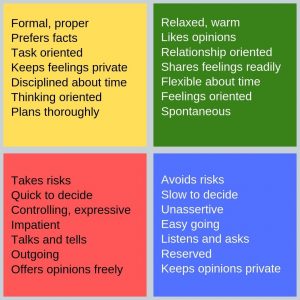I’ve had occasion to witness this from the sidelines of an organisation recently, and the ramifications are still rumbling on several months later. A good and necessary idea was introduced in such a way that hackles came up, noses were put out of joint and shutters came down – hardly the recipe for the great teamwork that was fundamental to the goal itself.
At workshops I facilitate for Team Thinking, we often talk about a favourite meal – what would it be, how would it be served? And then how would you feel if that perfect dish was then just dropped in your lap, spilling everywhere?
Delivery, then, is obviously key – but what else is going on here?
Why is a good idea not obvious from 360 degrees?
We know that we are all diverse, unique individuals with our own opinions. But how often do we really think about how our audience WANTS to receive our message? Are we sometimes guilty of just communicating our way, without really thinking about the communication style of the other person?
This image helps to illustrate the point:

What do you see? It’s a toad, right?
A friend of mine would not be able to look at this without getting the heebie jeebies if I hung it on my wall. Frogs and toads have lots of negative connotations for him.
However, if I just turn it 90 degrees, it’s a different story…

Problem solved, he loves horses!
Nothing was wrong with the picture per se – it was purely personal perception that created the issue. The dimensions haven’t changed, but just viewing something from a different angle has converted a strong negative to a positive.
And there’s more…
We all look at the world in different ways, due to our culture and background, but also our ongoing environment and experiences as our brains develop into fully-formed adults.
Neuroscience has shown how the four quadrants of our brains are wired for different behaviours, and the PRISM Brain Mapping tool is terrifically useful for illustrating this. Whilst we all have a blend of these characteristics, we tend to have an innate individual preference for one of these four areas:

Unless they’re genuinely a psychopath, no-one intentionally gets up in the morning with the goal of winding up their family or colleagues. But someone with a high red preference, for example, could very easily upset a high blue individual blue, just by being a bit too red!
So, how do the PRISM types like to be communicated with?
For deeper insight, I would recommend attending a PRISM Workshop, but as a starter for ten:
HIGH RED – These are task-oriented, quick decision-makers so be brief, be direct, be well-informed and focus on the results.
HIGH GOLD – Also task-oriented, these are detail people, so provide lots of – accurate – information, allow time for response.
HIGH BLUE – For these natural empaths, be clear on how everyone will benefit, ask how they feel about it
HIGH GREEN – These empathetic innovators less resistant to change, so try asking for ideas for getting others involved; emphasise how it will make things more interesting.
And remember – we are all a blend of these behaviours, and can access them at will, so wherever on the chart above you feel more comfortable, be prepared to flex when you want your messages to be received the right way, the first time!!